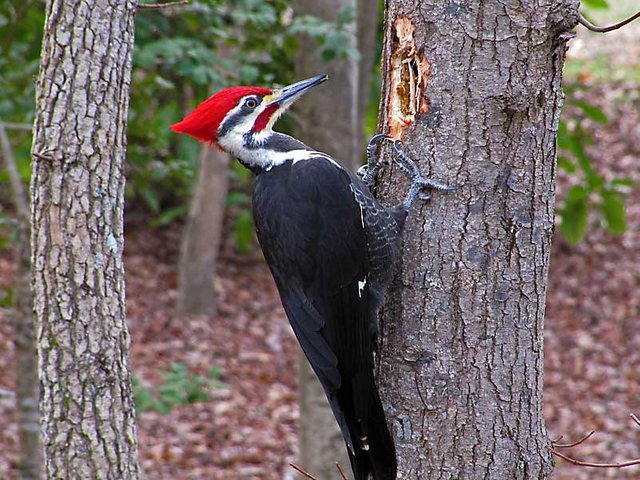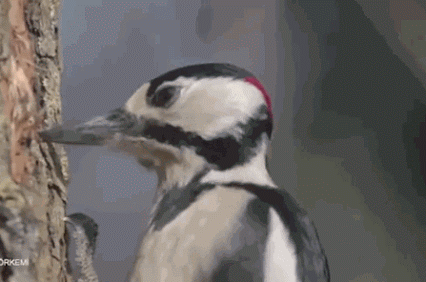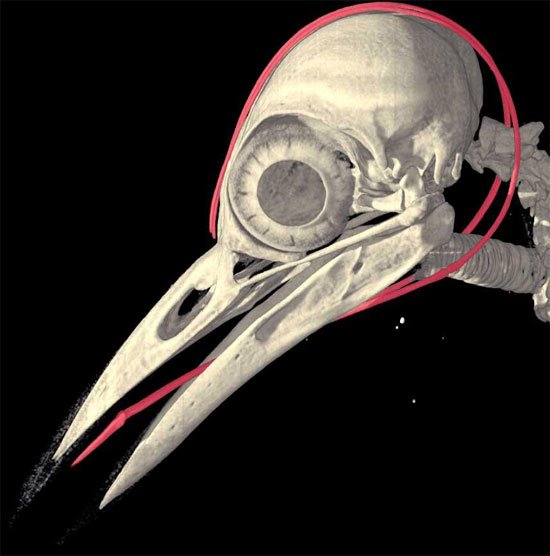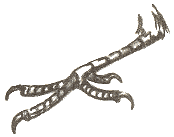Woodpecker and his "jackhammer"

Woodpeckers (Latin Picidae.) - A large family of birds, which includes 233 species. In most cases, woodpecker lives in the forests. This Climbing woody birds that fly, but not very well. The vast majority of members of the family differs from other birds unusual chisel-shaped beak. With it, woodpeckers hammering crust and the core of the tree, trying to find the root your food: insects and their larvae.
His sturdy beak woodpeckers are used not only for food production but also to create nests, which are usually satisfied in the hollows of trees. Knock on wood woodpecker and to communicate with each other. In the spring the males of many species of woodpeckers peck on dry trees. woodpecker body almost perfectly adapted to its way of life. This woodpecker can withstand heavy loads, which are deadly for many other organisms.
Slotting wood - a very energy-intensive activity. In order to replenish energy reserves, woodpeckers have to constantly eat. For example, the black woodpecker in just one "meal" can eat around a thousand or a few hundred ants bark beetle larvae. Green woodpecker eats and even more - a day he eats about two thousand ants.
Woodpeckers called orderlies forests, and it is, in principle, it is true. Bird eating a large amount of larvae of pests of trees or adult insects prevents an uncontrolled increase in pest populations.
Loads that can withstand woodpecker
The average speed of a woodpecker strikes - 20-25 movements per second. A total number of hits inflicted woodpecker on a tree at day - 8000-12000. To the bird was able to withstand the overload associated with the slotting of trees, its skull and skeleton must be unusually strong. If the tree as fast beat any other bird, then after a few strokes she would have died of congestion.
Measurements show that the congestion experienced by a woodpecker, reaching 1000 - 1200g. It is much more than can withstand the organisms of other animals, including humans. We are not able to withstand overload more than 80-100 g. Most (brief) overload the vehicle in which the person survived - 179,8 g. Paratroopers during the opening of the parachute experiencing overload up to 10 g. Pilots performing aerobatics, get overload up to 12 g.
The beak of the woodpecker is strong enough to batter a tree and not break or deform. The tip of the beak of most species of woodpeckers likes a chisel. This bird can "work" with the hardest types of wood. With the active chipping increases brain temperature. Therefore, a woodpecker can peck all the time, he had to take breaks to reset temperature.
In the woodpecker is not only strong skull and beak. This bird has a "shock absorber" as cerebrospinal fluid, which suppresses vibration. Amortization woodpecker system also includes elastic beak, sinewy and springy hyoid bone (hyoid), and particularly the cancellous bone in the head. Hyoid - this is more cartilage than bone. It is situated not only in the throat, but also comes into the nasopharynx, wrapping the skull. Thus, the cranium poultry is one of the most sophisticated natural absorbers.

Softens shot one factor, but the whole of the system. During chiseling, wood beak moves perpendicular to the surface on which beats woodpecker. If the attack was not perpendicular but slightly at an angle, birds amortization mechanism would not work, and she could just die. But it works the muscles coordinated system that allows the head and beak move in a straight line. On impact, the beak immediately triggers muscle pulls woodpecker's skull from striking places.
Protected against impact and birds eye. Upon impact on the tree woodpecker 🎯: ye drops third eyelid (nictitating membrane). It protects the eyeball from vibration, preventing retinal separation.
Another unique feature of the woodpecker - his long tongue. All birds tongue is attached to the back of the beak. But the woodpecker tongue comes out of the right nostril, divided into two halves. The two halves of the cover the bird's head and the neck, coming through a hole in the beak. Then they are connected. The language of woodpeckers take out insect larvae from deep strokes, done in wood.

In order to stay within the skull all the depreciation tools woodpecker had to sacrifice the size of the brain. In the process of evolution, he declined. Moreover, a decrease in brain volume did not lead to the fact that woodpeckers have become "dumber". In fact, woodpeckers have a high organization of behavior. They have complex territorial and socket habits.
Well, in order to easily move around the trunks of trees, woodpeckers use X-shaped structure legs. Two fingers on the foot woodpecker pointing forward, and two - ago. Most birds of other species are three fingers pointing forward and one - back. Keep the bark helps prehensile claws, strong bones, and tendons of the fingers. All this provides a secure grip on the tree and the woodpecker does not fall even during the most active "work".

Interesting!
Interesting! It'd be great if you cite your references/sources.
Ok, in next posts I will do it
Source: http://www.origins.org.ua/page.php?id_story=1617
Not citing the source of articles/photos, or using copyrighted photos, is plagiarism.